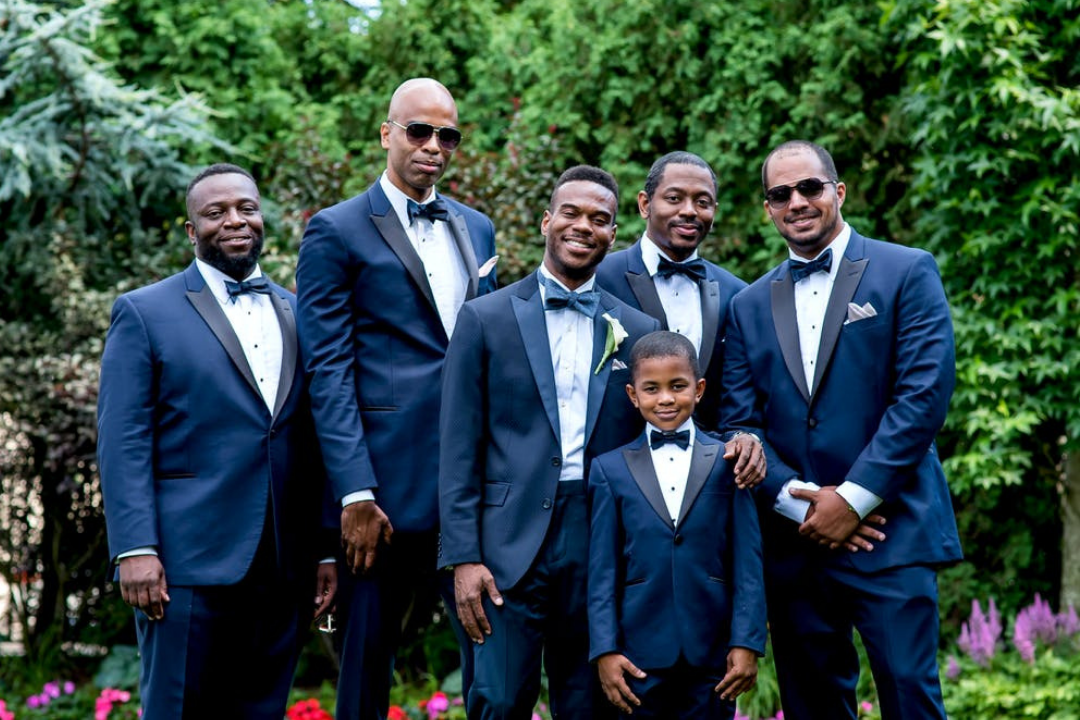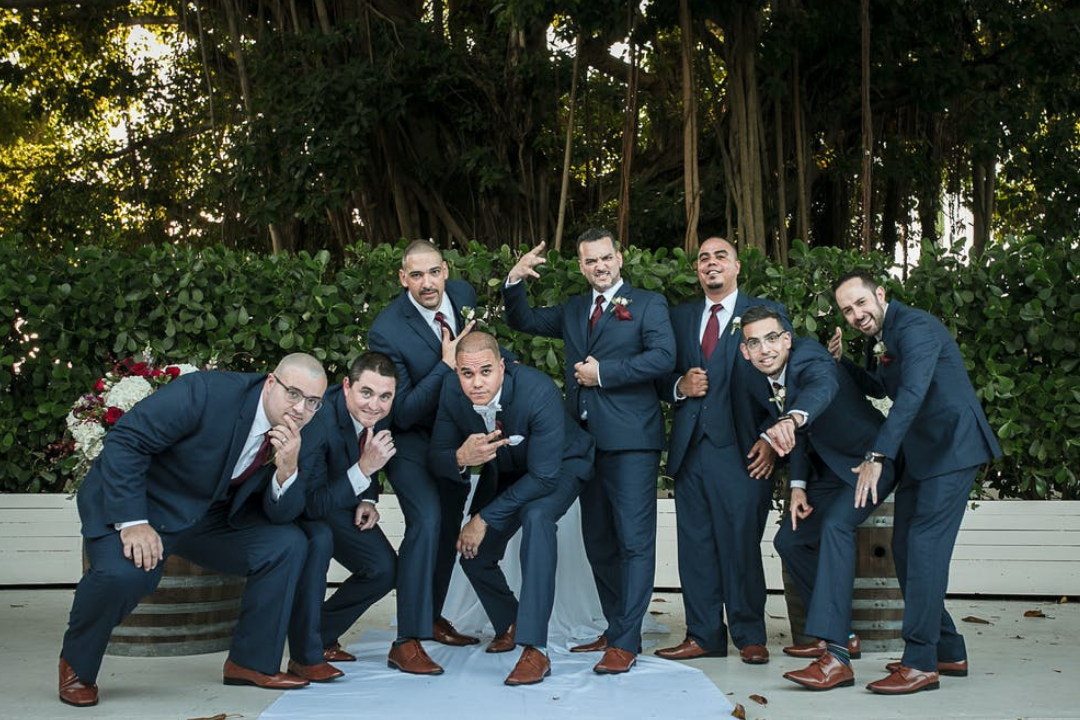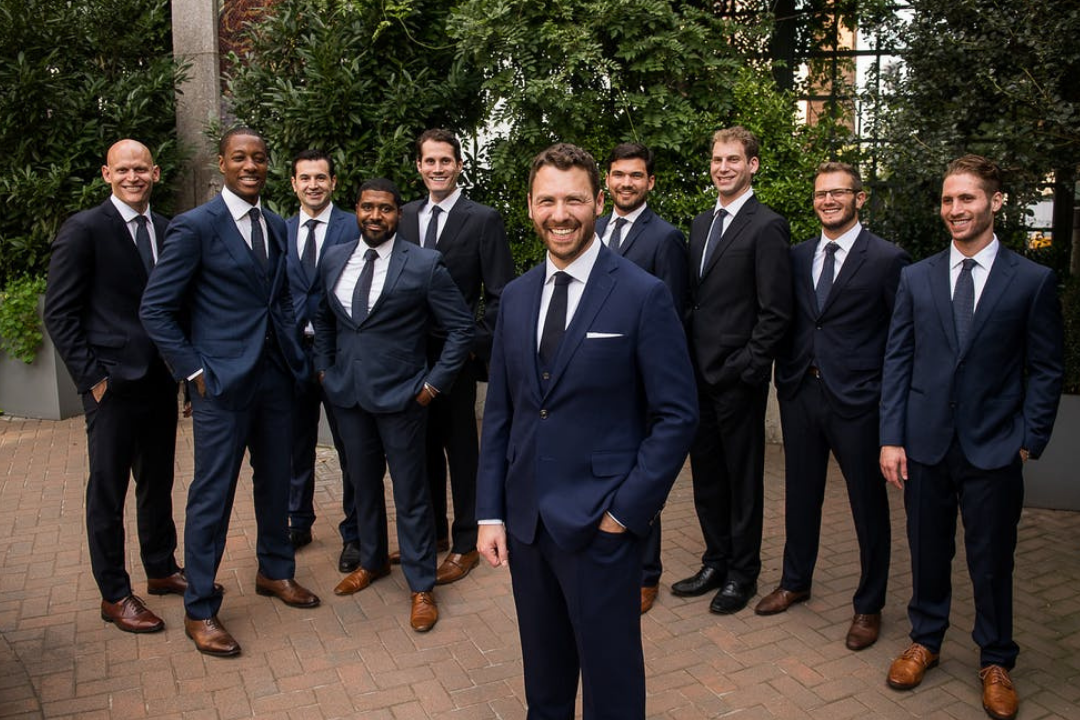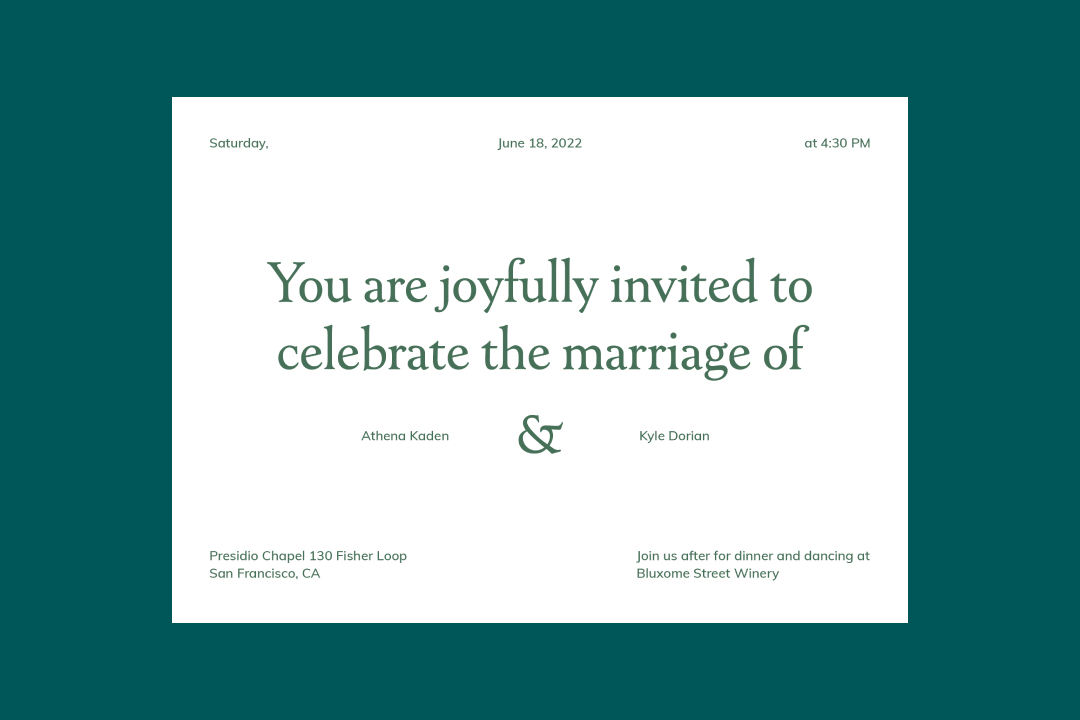- Expert advice/
- Fashion & beauty/
- Wedding attire/
- A Complete Guide to Wedding Attire for Grooms
- Wedding attire
A Complete Guide to Wedding Attire for Grooms
If you’re not sure where to start when it comes to choosing wedding day clothing for men, check out our guide to groom’s attire.
Last updated February 5, 2024

The First Look ✨
- The most important part of choosing your suit as a groom is finding out your body measurements from a professional tailor.
- Deciding whether to buy or rent a suit or tuxedo will depend on your budget, preferred style, desired wearability, and the level of formality at your wedding.
- Whether you’re looking to blend in or stand out, consider which styling details for jackets, waistcoats, trousers, and accents will compliment both your body type and your wedding theme.
The modern groom now approaches his wedding day attire as a reflection of his style and personality. While the classic wedding attire choices for grooms—a suit or tuxedo—are still the go-to attire for many grooms, others opt for more casual looks, like a dress shirt, slacks, and a blazer or a more laid-back linen shirt and khakis (perfect for a summer wedding).
The decision to wear a suit, tuxedo, or something less traditional on the big day is often a difficult dilemma for guys—especially now, when there are more attire options than ever. If you’re not sure where to start when it comes to choosing wedding day clothing for men, check out our guide to groom’s attire below.
Master Measurements
The most important part of choosing your suit is making sure that it’s sized appropriately for your body type. Getting measured is a must to ensure your wedding suit fits you perfectly and compliments your shape.
If you're getting a custom suit or tux, a professional tailor can take your measurements—and if you're getting your attire from a larger retailer, a salesperson can make sure you get measured accurately.
From there, the choices about suit vs. tux, individual garments, materials, and cuts will all be easier knowing exactly what sizes you should be shopping for.
The Difference Between a Suit and a Tuxedo
At first glance, there isn’t a whole lot of difference between the physical appearance of a suit and a tux. Here are the main differences between these two menswear styles:
- Tuxes tend to have satin features (such as the buttons, the lapels, and a stripe down the side of the pants) whereas suits do not.
- Tuxes are typically worn with bow-ties and a cummerbund or vest, and the jacket might have a tail.
- Suits usually have a standard suit jacket and are paired with a long tie (and sometimes a vest, depending on preference).
When choosing a suit or a tux, focus on which style makes you feel comfortable, fits into your budget, and matches the formality of your wedding.

The Pros and Cons of Suits and Tuxes
Suits
Pros:
- If purchased, can be worn multiple times after the wedding day to all sorts of events
- Easier to personalize to match the wedding theme
- Available in a wide range of different styles and colors
- Pairs easily paired with accessories, such as pocket squares, ties, boutonnieres, and shirts
- Can be more comfortable
- Great for slightly-less formal or informal weddings
Cons:
- Expensive to purchase
- Certain colors and styles, such as light-colored suits, are not appropriate in all settings and seasons and thus aren’t as versatile
- Looks out of place at really formal weddings
Tuxedos
Pros:
- Great for formal, black-tie weddings
- Can look more refined and polished
- Creates greater cohesion with less work for a large group of groomsmen
- Available in fewer styles, but cuts down on decision-making
- Most popular choice for grooms’ attire
Cons:
- Often not worn much after the wedding (unless the groom attends many formal, black-tie events)
- Very expensive to purchase
- Looks really out of place at informal weddings/events
- Requires a special type of dress shirt (typically white with black buttons)
- Though possible in other colors, black is the most widely available

Price Comparisons
The price of a groom’s suit or tuxedo really depends on a combination of factors:
- Where the groom lives
- The store(s) where he is shopping
- The suit or tuxedo design
- The menswear designer
- Whether you decide to rent or buy
- How customized the details are
- The quality of the materials
Because so many of these pricing factors are circumstantial, it’s best to shop around to compare prices in order to get a true comparison.
Buying Vs. Renting
- If buying, tuxes tend to cost more than suits.
- If renting, suits tend to cost more than tuxes.
And, of course, if you opt to forego a suit or a tux for something more informal, there’s a good chance you’re looking at a lower price tag. (For example, khakis and a linen shirt are likely going to cost less than buying a custom blue suit or renting a tux.)
Formality Matters
The formality of a wedding will play a major role in whether a tuxedo, suit, or more laid-back attire is the right choice for a groom. Here’s some general advice to keep in mind when choosing groom's attire:
- Suits are better for less formal events. Suits come in all kinds of different styles and can usually be tailored to fit various levels of formality, including semi-formal and casual weddings—while tuxedos tend to look out of place at more laid-back events (for example, a beach wedding).
- Tuxes are better for more formal events. If the event has a formal dress code then the groom’s attire should be formal as well.
- It’s best to match your the dressiness of your partner’s attire. Finally, the extravagance of the your partner’s attire should be taken into consideration. If your fiancé(e) is wearing something very formal or very informal, choose a look to match.
Religious and Cultural Attire
If your religious or cultural ceremony requires different formalwear beyond a traditional Western look, you will most likely be seeking out a specialty clothier or tailor who can craft the traditional wedding garments you need. These experts, along with any knowledgeable family and friends you might bring along, can help you select and get fitted for the outfit(s) you’ll wear on your wedding day.
Military Attire
If you are a member of the military, you may wish to come to your wedding in your full military dress. Many branches of the military have various uniforms for different types of ceremonies, each with varying degrees of formality. If you decide to opt for military attire, choose the most formal uniform or military dress suitable for your rank to wear to your wedding.
Suit Care Tips
- Make Sure It Fits — As a first step when trying on your groom attire, make sure that your suit, tux, or other clothing choices are properly tailored to your body.
- Take Care Of Wrinkles — Make sure you know how to take care of your ensemble. If your suit needs to be steamed or pressed to look its best, get it done ahead of time. Don’t forget to properly wash, store, and iron (if necessary) your shirts, ties, and other fabric accessories, too.
- Store Someplace Safe — Before (and after) the wedding, make sure that your groom attire is stored in a safe, secure place that’s free of moisture, extreme temperatures, or pests that can damage the fabric.

Styling and Details
While it might seem that grooms’ attire is pretty straightforward, there are plenty of pieces to mix and match to create the perfect wedding look.
Here’s a breakdown of the different menswear elements that typically make up a groom’s wedding day look:
Jackets
-
As a general rule, slimmer and shorter jackets are in fashion at the moment. Avoid baggy suits or jackets that are too long.
-
Customization is easiest to pull off on a groom’s jacket. Whether choosing a funky print for the jacket lining, or choosing a jacket in a bright color or unique fabric like velvet, there are many possibilities here for adding a little flair.
-
Single- or double-breasted? This term simply refers to the way your suit buttons.
- Single-Breasted: A single-breasted suit has one row of buttons (usually no more than three) down the center.
- Double-Breasted: Double-breasted suits, as the name implies, double up, meaning you have four, six, or eight buttons in two adjacent rows.
Single-breasted jackets are more popular, as double-breasted jackets tend to look like they come from a very particular period in time—which might be handy if you’re having a retro-themed wedding.
-
Don’t forget the lapels. There are three main types:
- Notch: The notch lapel is the most common; it’s so named because there is a notch where the collar starts and the lapel ends.
- Peak: A peak lapel tapers into a point angled toward your shoulders. It’s a very formal, fashion-forward cut and can look out of place on the wrong suit. Suits with peak lapels tend to be more expensive because they’re more difficult to sew.
- Shawl: Shawl lapels are usually only seen on tuxedos and dinner jackets and feature a continuous curve. They’re very distinctive and also highly formal.
-
Even though they seem like small details, the type of buttons and cut of pocket that you choose will really affect the overall look of your suit. Don’t neglect these small, but impactful points of tailoring when choosing your wedding suit.
Waistcoats (or Vests)
- A waistcoat is usually the third part of a three-piece suit, or the star of a more dressed down shirt-tie-waistcoat ensemble. They button in the front and have a built-in cinch at the back so you can adjust how fitted the waistcoat is to your body.
Trousers
- Dress pants are available to you in all the same cuts as a normal pair of pants, and how they hang on you will really affect their look. The most crucial part of choosing the right trousers is making sure that they are the right length, revealing just the right amount of ankle. The area where your shoes touch the hem of your pants is called the break of the trousers. There are three main types:
- No Break: No break means the pants don’t actually touch your shoes, which has the effect of making your legs look a little longer.
- Half Break: Trousers with a half-break rest on the top of your shoes and are the most standard trouser length.
- Full Beak: Finally, there’s the full break, which means the fabric folds all the way around the ankle where it hits your shoes. Trousers with a full break can be hard to pull off well, especially on shorter men, who run the risk of looking like they forgot to get their pants hemmed at all.

The Accents
Even if you go classic with the main aspects of your wedding day look, there’s room to personalize on a smaller scale with accessories. Whether it’s a patterned tie or a pair of heirloom cufflinks, these details can add sophistication and let your unique self shine. Here’s a breakdown of accessories to consider adding to your groom’s attire:
Traditional Accessories
- A bowtie or tie
- A belt and/or suspenders
- A watch
- Cufflinks
- A tie clip
- A pocket square
- Socks
- Shoes
Additional Accessories
- Jewelry
- Sunglasses
- A hat
- A scarf
- A lapel pin
When it comes to your wedding day look, here are a lot of menswear choices to consider. To make the decision-making easier, start slowly by consulting experts at local shops and browsing through our collection of Real Weddings for other groom looks. And remember—there’s no need to stress. This is about having fun and finding attire that makes you feel comfortable and confident. When all is said and done, you’ll look sharp while marrying the love of your life.
Up next for you

What’s Your Wedding Dress Style?
Inspiration
Finding the perfect wedding dress can sometimes feel as challenging as finding your soul mate. Luckily we’re here with a quick-and-easy quiz to help you figure out your ideal wedding style.

How to Choose Your Wedding Shoes
How-To
Not sure how to find the right heels or kicks for your big day? Here are some tips on choosing the perfect wedding shoes.

DIY Wedding Hair Tips
Wedding Hairstyles
Perhaps you’ve decided to style your own hair for your wedding to save time and money, but suddenly realize you have no idea how to do wedding hair. Don’t worry, we’re here to help. Opting for a DIY wedding hairstyle can be intimidating, but all it takes is a little preparation to pull it off flawlessly. Luckily there are some tried and true DIY wedding hair tricks that you can use to make sure you look amazing when you walk down the aisle. Here are our DIY wedding hair tips to follow for gorgeous wedding hairstyles you can pull off yourself.

A Step-By-Step Guide to DIY Wedding Makeup + 10 Tips
Wedding Makeup
To make sure that your wedding makeup is flawless and you’re looking your best on the big day, check out our tips for DIY wedding makeup below.

What to Wear to a Bridal Shower as a Guest
Inspiration
Find ideal attire for a bridal shower. Explore outfit ideas, styles, and tips to shine as you celebrate the bride-to-be's special day
Featured

What Is a Registry (And Why Do You Need One)?
Inspiration
A wedding registry is a personalized collection of gifts that an engaged couple has specifically chosen for their guests to shop from in order to make the wedding gifting experience simpler, easier, and more satisfying for everyone.

Wedding Invitation Wording: A Complete How-To Guide
How-To
Learn the how-to's of wedding invitation wording, plus formal and casual wedding invitation examples from the experts.

A Guide to Bridal Showers
Inspiration
This bridal shower guide will introduce you to the basics of bridal showers: traditional bridal shower etiquette (and which of those “rules” you can break), whom to invite, what to do, and who pays for it all.

How to Plan a Wedding: A Step-by-Step Guide
How-To
We’ll walk you through the steps of online wedding planning, highlighting all of Zola’s incredibly easy and intuitive online wedding planning tools that’ll make planning for the big day more fun and less frustrating.

Wedding Cake Cost Guide: Average Price and Budget Tips
Advice
Wedding Cake Costs: Discover the national average of $917, typical range of $700 to $1,100, and smart ways to save on your wedding dessert.
- Expert advice/
- Fashion & beauty/
- Wedding attire/
- A Complete Guide to Wedding Attire for Grooms
Find even more wedding ideas, inspo, tips, and tricks
We’ve got wedding planning advice on everything from save the dates to wedding cakes.
